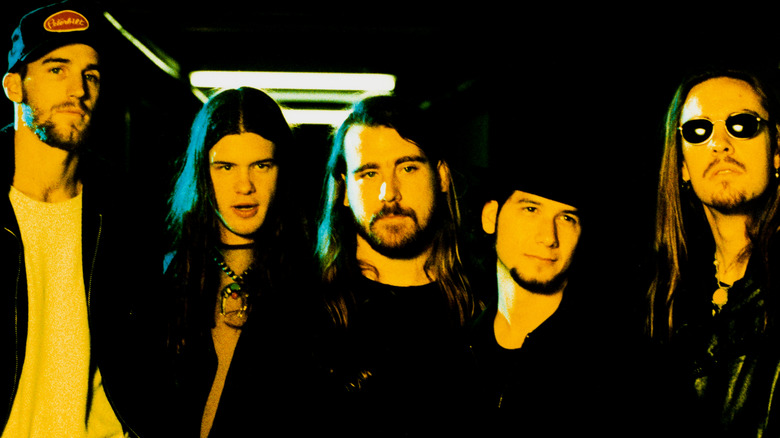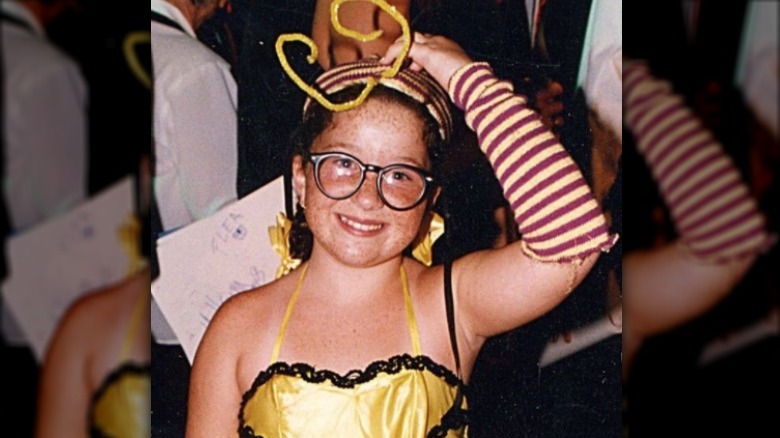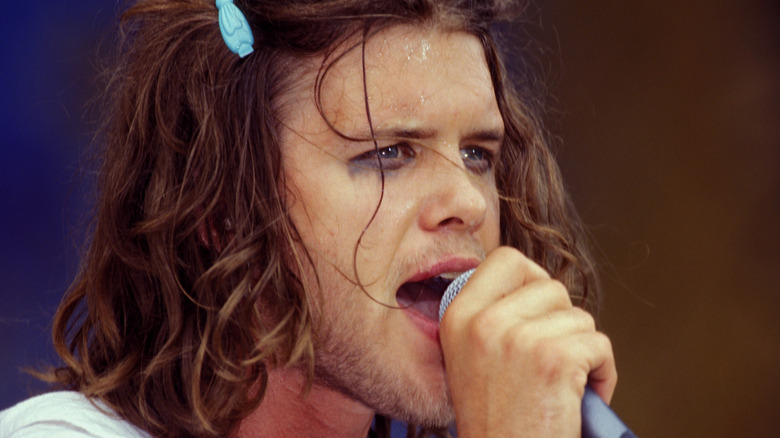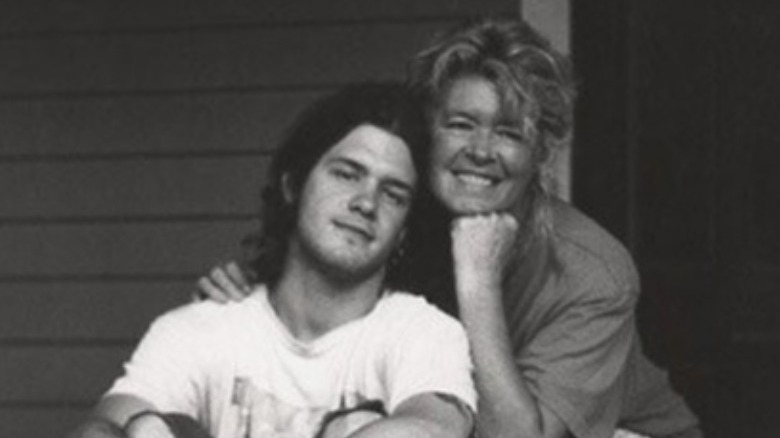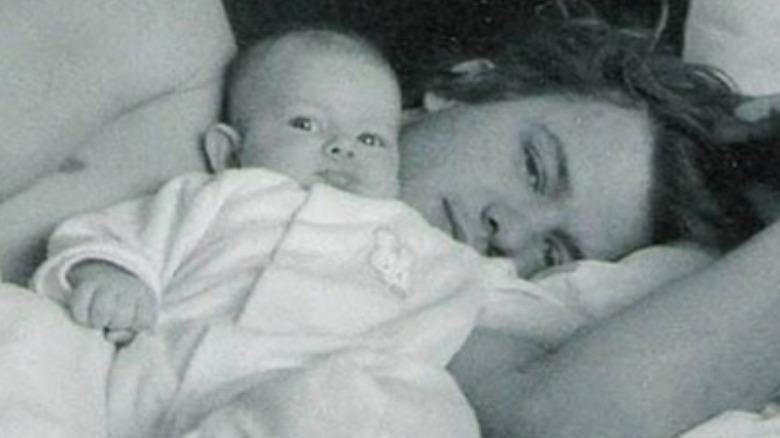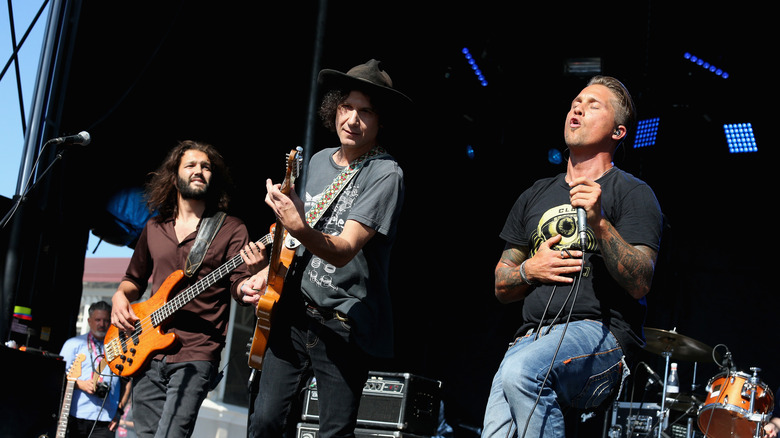The Untold Truth Of Blind Melon
The members of Blind Melon started out as five small-town musicians from different parts of the U.S. who moved to L.A. to pursue their rock star dreams, only to see those dreams materialize and dissolve within a few short years. According to Loudersound, guitarist Rogers Stevens and bassist Brad Smith were friends from West Point, Mississippi, and they knew drummer Glen Graham from Columbus, Mississippi, while guitarist Christopher Thorn hailed from Dover, Pennsylvania, and Singer Shannon Hoon grew up in Lafayette, Indiana. If you've heard of any of those places, it probably wasn't for their music scenes.
Still, the five guys, each deep in the L.A. music world around 1990 in different ways, found each other. They soon realized they seemed to have better musical chemistry with each other than they were finding with the locals. Stevens, Smith, and Thorn had been playing with a drummer from L.A., but according to Loudersound, after meeting Hoon and realizing he was the frontman they were looking for, they reached out to Graham who traveled out to L.A. from Mississippi to round out the band.
Now, they needed a name. Loudersound reported that "Blind Melon" was something Smith's dad used to call hippies back in Mississippi. Per Urban Dictionary, one definition of the name means to be "a person that lives life oblivious to social norms. A non-conformist. A free spirit. A blind mind."
Blind Melon's biggest hit was written before they became a band
From there, things moved quickly for the band. By 1991, they were signed to Capitol Records, but the Los Angeles party scene was proving too distracting to make a record, according to Loudersound, so the five musicians packed up and went to Durham, North Carolina where they rented a house they called, "Sleepyhouse," (hence the song by the same name on their debut album, per Blind Melon) and focused on music, mostly.
Bassist Brad Smith told Loudersound, "We weren't going to leave and go out on the town, cause there's nothing to do in Durham, so we just played music, smoked weed, and everyone was into painting at the time. It was a blast. It was a very strange environment. Shannon tin-foiled the windows, so it was always dark in there, with candles. Rogers didn't take off his pajamas for a week."
They recorded the material they came up with at Sleepyhouse in Seattle in early 1992 for their self-titled debut album, but two of the album's songs were written by members of Blind Melon before the group even became a band. According to Loundersound, "Change" was Hoon's song, and the band's breakout song, "No Rain" — bolstered by the success of its sunshiny music video featuring a dejected little girl in a bee costume turned joyful dancer — was written by Smith about an ex-girlfriend who was often depressed.
Too much of a good thing
At first, things were going great for Blind Melon. In a relatively short amount of time, they got a record contract and their first album went double platinum, according to Honors Music Awards.
All the while the record was building momentum, they toured for about a year and a half, which seemed like the thing to do at the time according to what Smith told Loudersound. Looking back, however, he realizes maybe that was kind of detrimental.
"The pitfalls of keeping the band on the road — idle hands are the Devil's workshop, and Shannon took that proverb to heart," Smith said. "He'd made a mess of himself on the road after a certain point, and we should have gotten off the road sooner. Hindsight is 20/20. We should have been in the States when "No Rain" was getting played on the radio but we were in Europe touring with Lenny Kravitz for two months. It was just small mistakes that brought down a flying ship."
Smith went on to say, "But these great tours kept coming up, and the managers were convincing members that we should take advantage of this. And from a business standpoint, you trust them. But from a longevity standpoint, I don't think it was the right thing to do."
Hoon was always the wild card
Shannon Hoon "making a mess of himself" was an on-and-off situation within the band, but it wasn't new for Hoon. Stevens told Loudersound, "Shannon's drug use ... that was from day one. That wasn't a new thing. I mean, he went through phases; he was always game for whatever. I think he had a lot of problems back when he was living in Indiana, and he got out."
Cocaine was Hoon's drug of choice. The other guys partied too, but sometimes there is that one person in the group who is obviously going too far too often. Stevens said Hoon would go into rehab sometimes and another time they tried to stage an intervention but Hoon didn't show up.
According to Rolling Stone, Hoon's mom, Nel, said in the last few years before he moved to L.A., things were pretty bad between his drug use and constant run-ins with the law.
Nel said, "I'd hear an ambulance and if Shannon wasn't home, I'd get sick to my stomach. I always expected the worst. When he got into drugs, I just gave up hope. He just turned 26, and there were times I didn't think he'd live that long. It was to the point where the police wanted him so badly that they'd put a finger on him when he hadn't even done anything. They just wanted him out of the way."
Blind Melon's second album initially fell flat
After the band's long tour, they had some downtime in different cities and came together again at Woodstock, 1994, Loudersound reported, which guitarist Christopher Thorn called "overwhelming," but Hoon showed up in a dress and gave it his all. Shortly after, the band reconvened in New Orleans to work on their second album, "Soup," which was a departure from the happy hippie vibes of "Blind Melon".
The band thought they'd crushed their second album, consciously trying to do something different from their debut album so when it got bad reviews, they were understandably "devastated," as Thorn told Grammy, adding, "We thought we made this amazing record, and we thought everyone was going to be super proud of us for not trying to repeat 'No Rain' again. We thought we had made 'Exile on Main Street.' Then the review comes out and someone says, 'Hey, what you made, that you were so proud of, is absolute s***.'"
Yet "Soup" was a slow burn, holding up over time. Grammy called the album "a dark-horse favorite of the alt-rock era among fans and critics."
The band went on tour again in 1995 to promote the record. Hoon even got clean for a while on that tour when his daughter was born, but he didn't stay that way for long, per Grammy.
Hoon died of a cocaine overdose on the tour bus, but Blind Melon lives on
Blind Melon arrived back in New Orleans on October 21 to play a show on the "Soup" tour. According to Loudersound the night before Hoon had stayed up doing cocaine all night on the bus, and when the bus arrived in New Orleans in the morning the band checked into a hotel, but Hoon was restless. He left the hotel to walk around the city.
Early that afternoon the band's sound engineer found him on the bus and couldn't wake him, so they called for help. It was too late by the time emergency workers arrived. The 28-year-old was pronounced dead at 1:30 p.m. that afternoon, MTV reported. The cause of death was a cocaine overdose.
After Hoon's death, Blind Melon tried to keep the band going, releasing an album of outtakes and a documentary, according to Blind Melon's website, but they couldn't find anyone who felt right to replace Hoon, and the band officially called it quits in 1999. But there was a rebirth for the band around 2006 and 2007 when some of the members brought in Travis Warren to serve as frontman, and Blind Melon started playing clubs and recording again. A decade later, they were still playing together, and according to Blind Melon, "once again caught lightening [sic] in a bottle ... in sum, Blind Melon is back."
